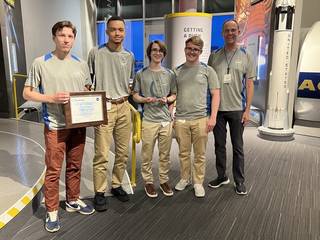The Boston University Team, with their project titled Aluminum Powder Combustion, took first place at the second annual Gateways to Blue Skies Competition. Competing among eight finalist teams who presented their ideas for potential clean aviation energy sources of the future, the Boston University team earned the top award at the 2023 Blue Skies Forum, hosted at NASA’s Glenn Research Center on June 1-2. The Forum was judged by subject matter experts from NASA and industry.
Boston University Aluminum Powder Combustion team members were awarded an opportunity to intern at any of the four NASA Aeronautics Centers — Langley Research Center (Hampton, VA), Glenn Research Center (Cleveland, OH), Ames Research Center (Mountain View, CA), and Armstrong Flight Research Center (Edwards, CA) —across the country during the 23-24 Academic Year.
“Being selected to present our research as finalists at the Blue Skies Forum was more than enough; our team is honored and thrilled to have received the first place award,” said team lead Patrick Olah. “Thank you to all the event coordinators for organizing such a great event, to the incredible engineering professionals for their time and expertise, and to our fellow teams who presented alongside us. We look forward to seeing what Blue Skies has in store for the future!”
Advisor Jim Geiger added, “(We) are thrilled with winning the 2023 NASA Blue Skies Competition. I am so proud of how my team performed this week at the Finals, and for that matter since last September when the team formed and started working on this exciting challenge. Since the beginning, they have been focused, professional and driven to deliver a winning solution. And they did! Congrats to them, they are very deserving.” He added, “As for the other seven finalists, I was so impressed … I am very confident that we all will be well served by the next generation of engineers and scientists that are blossoming before our very eyes.”
Second place went to University of California, San Diego with their project, Aircraft Propulsion by Directed Energy Beam Bursts (DEB-B).
Other awards included:
-
Best Presentation: Carnegie Mellon University | The Role of Hydrogen in Aviation Decarbonization
-
Best Infographic (Tie): University of California, San Diego | Aircraft Propulsion by Directed Energy Beam Bursts (DEB-B) Manhattan College | High on Hydrogen!
Sponsored by NASA’s Aeronautics Research Mission Directorate’s University Innovation Project, the Gateways to Blue Skies Competition is an initiative to engage college students in researching climate-friendly technologies and applications that will establish a zero emissions future for aviation. The 2023 theme asked students to investigate and conceptualize the source-to-flight lifecycle of one potential clean aviation energy source of the 2050s, in terms of feasibility, viability and environmental impact.
Finalist teams presented concepts that included metal, hydrogen, energy beaming, and nuclear energy solutions. They offered specifics about storage, cost, transportation, scaling, optics, supply chain characteristics and other aspects about how these diverse fuel alternatives could reduce aircraft carbon emissions.
By crowdsourcing potential new energy sources and analyzing the entirety of the supply chain’s climate impacts, teams are helping inform the “clean aviation energy” source of the 2050s.
“The variety of novel ideas NASA has received as a result of this year’s competition is great,” said Steven Holz, NASA Aeronautics University Innovation Assistant Project Manager and Blue Skies judge and co-chair. “These students are passionate about what NASA and the aviation industry are doing in support of green aviation, and they’re bringing their best effort to meet us at the table.”
At the Forum, students also had the opportunity to network with NASA and industry experts, tour NASA’s Glenn Research Center, and gain insight into potential careers and applications that will further the Agency’s mission toward eco-friendly aviation.
“We are beyond impressed with how the teams embraced this year’s theme of clean aviation energy,” added Andy Provenza, NASA Aeronautics University Innovation Project Deputy Project Manager for Technology and Blue Skies judge and co-chair. “This competition allows students to gain real-world experience, while NASA and the aviation industry gain ideas, and work being done to reduce our carbon footprint gains momentum. I should add that it’s also tremendous fun to attend the Forum itself and see today’s experts mingle with the next generation of aeronautics professionals, listen to thoughtful presentations, and tour NASA facilities.”
The 2023 Gateways to Blue Skies Competition is sponsored by NASA’s Aeronautics Research Mission Directorate and administered by the National Institute of Aerospace.
****
View the livestream of the competition presentations: https://livestream.com/viewnow/blueskies
View the competition finalists: https://blueskies.nianet.org/finalists/
To learn more about the 2023 Gateways to Blue Skies: Clean Aviation Energy Competition, visit: https://blueskies.nianet.org/competition/
For more information about NASA Aeronautics, visit: https://www.nasa.gov/topics/aeronautics/index.html



























